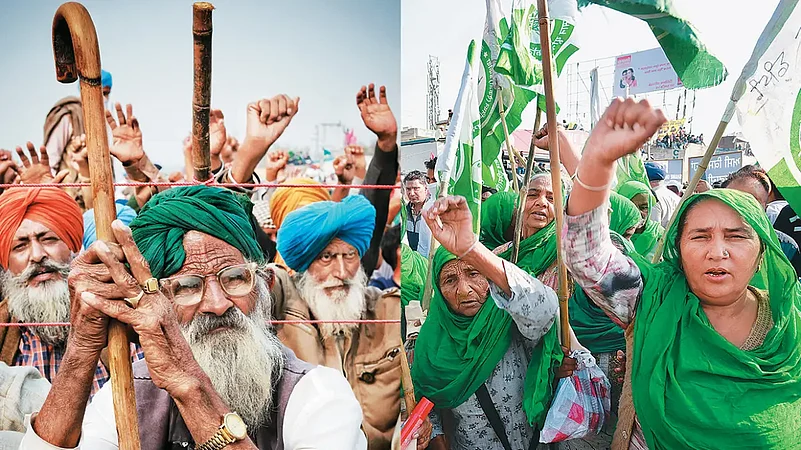Navreet Sivia, 33, a resident of village Sivian in Bathinda district of Punjab’s Malwa region, quit his secure job at a Jalandhar-based TV channel in May 2020 to take the most daring decision of his life. A postgraduate in Journalism and Mass Communication from Punjabi University, Patiala, Sivia started dividing his time between farming and journalism. Restless to set up his own digital media platform, he availed a loan of Rs 8 lakh and went ahead with his friend Karan Sharma, 28, to start a digital news platform, Akhar (Punjabi for alphabet, like akshar in Hindi)— that at present has 7.12 lakh subscribers on YouTube and 6.5 lakh followers on Facebook.
As they embarked on their professional journey together, the Punjab farmers’ agitation was growing simultaneously, and this proved to be a fertile ground for them. While established media outlets chose to ignore the anti-farm law protests till the farmers reached Delhi borders on November 26, 2020, Akhar had already created an audience for itself. From the revenue this coverage generated, Sivia could not only clear his debt, but also build a small team.
Just like Akhar, several other news platforms came to prominence in Punjab during the protests against three controversial farm laws that the Narendra Modi government finally revoked last year. While farm leaders frequently got into heated arguments with the representatives of the pliant (pro-establishment) media, they invariably heaped praises on alternative media journalists — proponents of mobile phone journalism who use smartphones and social media to report stories. However, during the elections, according to media observers, most of them started showing political biases, compromising on principles of impartial and objective reporting.

For Sivia and his team, their passion for storytelling overshadows any monetary gains. “Even today, we don’t have an office. We have a team of six persons and we operate from different parts of Punjab. From reporting to shooting, editing to social media handling, everyone in the team has to multitask,” Sivia tells Outlook, adding, “During this election, several political parties approached us and offered us money, like they do with other digital news organisations. But we did not accept a single penny.” Maintaining that his organisation does not have a steady stream of income, Sivia says, “Our salaries keep fluctuating as per the number of views our stories get online.”
Sivia’s team has done several exclusive stories which created an impact and led to a quantum jump in Akhar’s viewership. One such story was of an orphan brother and sister that Akhar reported on August 1, 2021. “The children had no one to look after them. They were living in a dilapidated house after their parents died. Most of the time, they would sleep on an empty stomach. The story went viral within no time. At present, it got 9.4 million views.” Sivia adds that many viewers reached out to the children and helped them in every possible way. “Our report changed their lives. And whatever revenue the story generated, I handed it over to the children.”
Despite limited resources, he adds, Akhar has been campaigning against orthodoxy and superstitions, both deeply rooted in Punjab society. Gurshamshir Singh, 32, is Chandigarh-based bureau chief of NZ Punjabi News, set up in 2015. “Our organisation, a small team of nine, runs on funding from Punjabi and Sikh diaspora,” Singh tells Outlook about his organisation that has 8.82 lakh subscribers on YouTube and over one lakh followers on Facebook. “We only highlighted issues that are important for Punjab’s future,” Singh says about their coverage of the 2022 state assembly elections.

According to Singh, this election felt different from the previous polls. “It was not an issue-based election. The ruling Congress party was a divided house, but people largely were not in a mood to give Shiromani Akali Dal (SAD) another chance. No one was talking about real issues like the agrarian crisis and drug menace. Unlike previous elections, political parties were almost silent on the issue of blasphemy. The slogan, Ik Mauka Kejriwal Nu (One chance to Arvind Kejriwal) seems to have worked for the Aam Aadmi Party in Punjab as people were really desperate for a change, having seen the work done by all traditional parties.” Even Singh admitted that his outlet became noticeable during the farmers’ agitation.
Even senior journalists working with established media houses in Punjab privately admit that admit that the alternative media covered the farmers’ agitation far better than the mainstream media. “Undeniably, they upheld public interest. However, during the assembly elections, they lost their objectivity and started showing their bias towards certain political parties and religious organisations. It could be because of lack of professional training or financial compulsions, or both,” a Chandigarh-based resident editor of a national daily tells Outlook on the condition of anonymity, adding, “They usually forget the thin line between activism and journalism.”

Jagtar Singh, a Chandigarh-based author and veteran journalist, believes that Punjab always had the space for alternative media. “I was with the Indian Express during the militant movement in Punjab. I realised how the mainstream media ignored and deliberately distorted certain aspects of the conflict, and still does not look at certain issues from the peoples’ perspective. Had the mainstream media been doing its job passionately and objectively, this space [alternative media] would not have existed,” observes the Chandigarh scribe. Commenting about the allegations against alternative media practitioners concerning their lack of professionalism and objectivity, he says, “Our thought processes are shaped by the environment in which we live. Even in the mainstream media outlets, we see reporters working in a certain way as told by the management.”
ALSO READ: Media And Manipur: Courage Under Fire
Aarish Chhabra, a journalist-academician, whose current research focuses on such regional social-media news channels, has a different take on the allegation that the social media news channels violate the norm of objective reportage. “This is not necessarily a bad thing on a platform as dynamic as social media, where paid trolls can make fake news viral. Journalism does not operate in a vacuum,” Chhabra reasons.
Regional social media channels — wittingly or just naturally — play an additional role of being the ‘sub-national voice’, says Chhabra. “The channels that focus on Punjab have a unique niche in Indian and subcontinental history, and also play the role of being the state’s spokespeople. We must not forget that Punjab is a region where a national minority of two per cent, that is the Sikhs, is a majority of about 60 per cent. After Jammu and Kashmir became a Union Territory, Punjab was the only Indian state to retain such a unique demographic character,” he elaborates, adding, “The ‘spokesperson-like’ behaviour of regional social-media channels gives these regions a tool to counter the centralising, illiberal and hyper-nationalist polity, culture and mediascape of the Hindi-Hindu-Hindustan variety.”
Referring to the farmers’ agitation, he continues, “This tool — naturally or otherwise — came in handy when farmers protesting on Delhi’s borders needed a strong voice to counter the pro-central government and anti-protester narrative being run by the mainstream media, particularly Hindi language media.”
In this context, Chhabra says, “these regional channels force us to rethink the idea of ‘New India’ being sold aggressively these days. From a wider perspective, this begets a basic question: Will a surge of regionalism counter India’s current politics of centralisation of power? The success of these channels seems to point towards a resounding ‘yes’.”
(This appeared in the print edition as "Staying True to a Protest")
ALSO READ


























